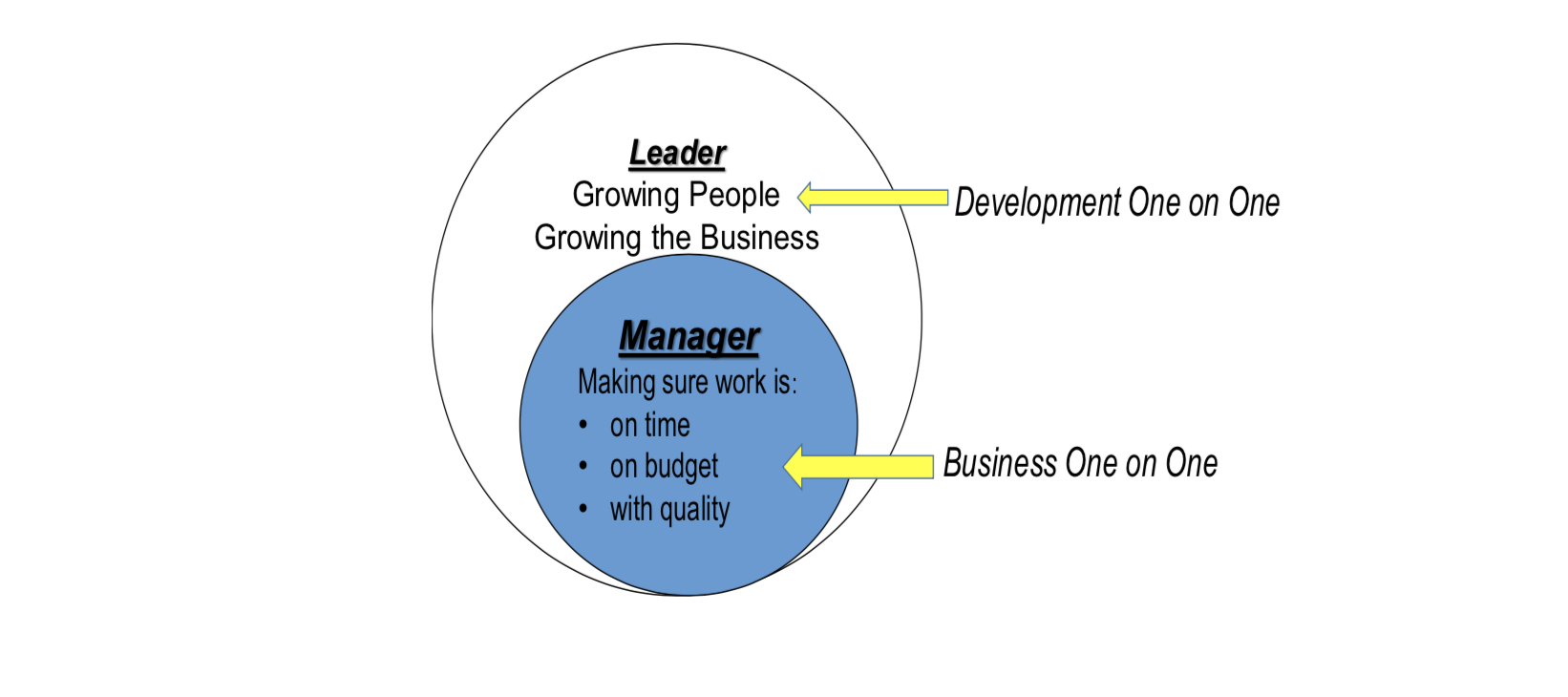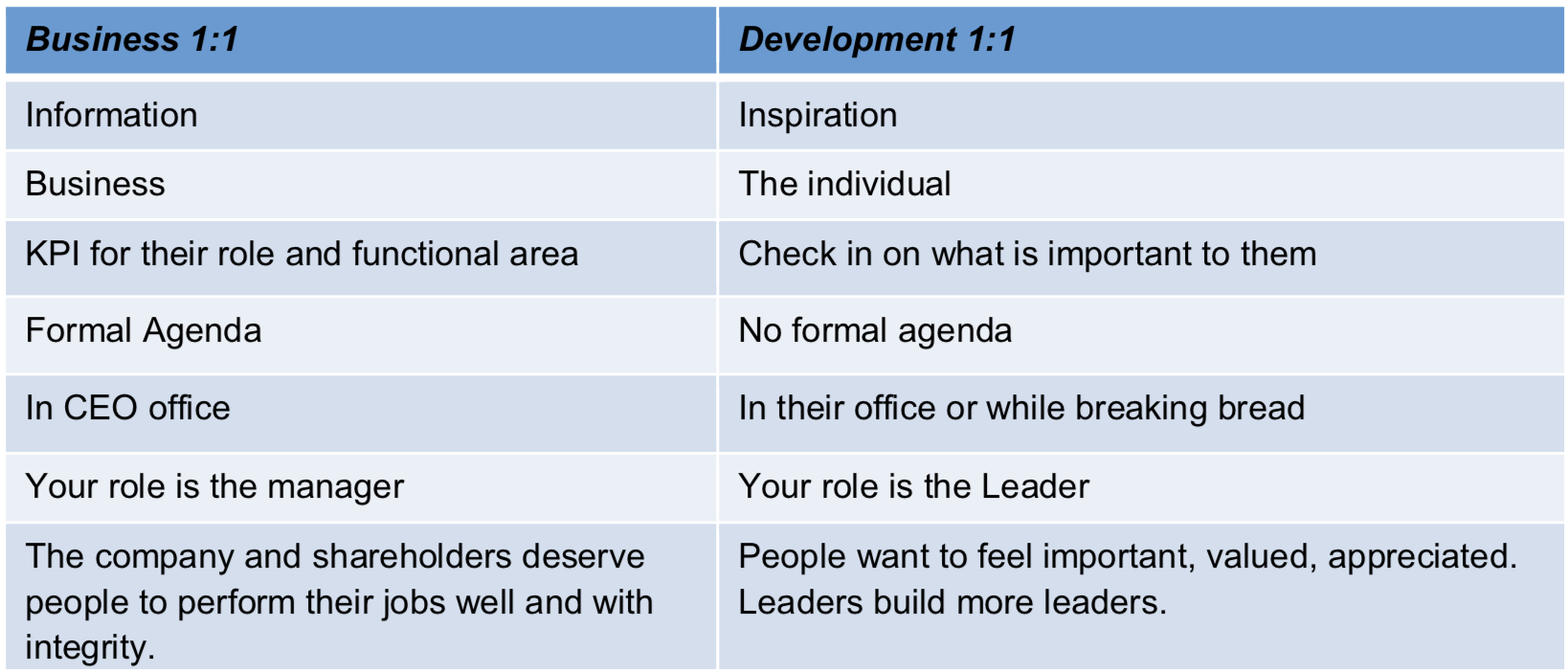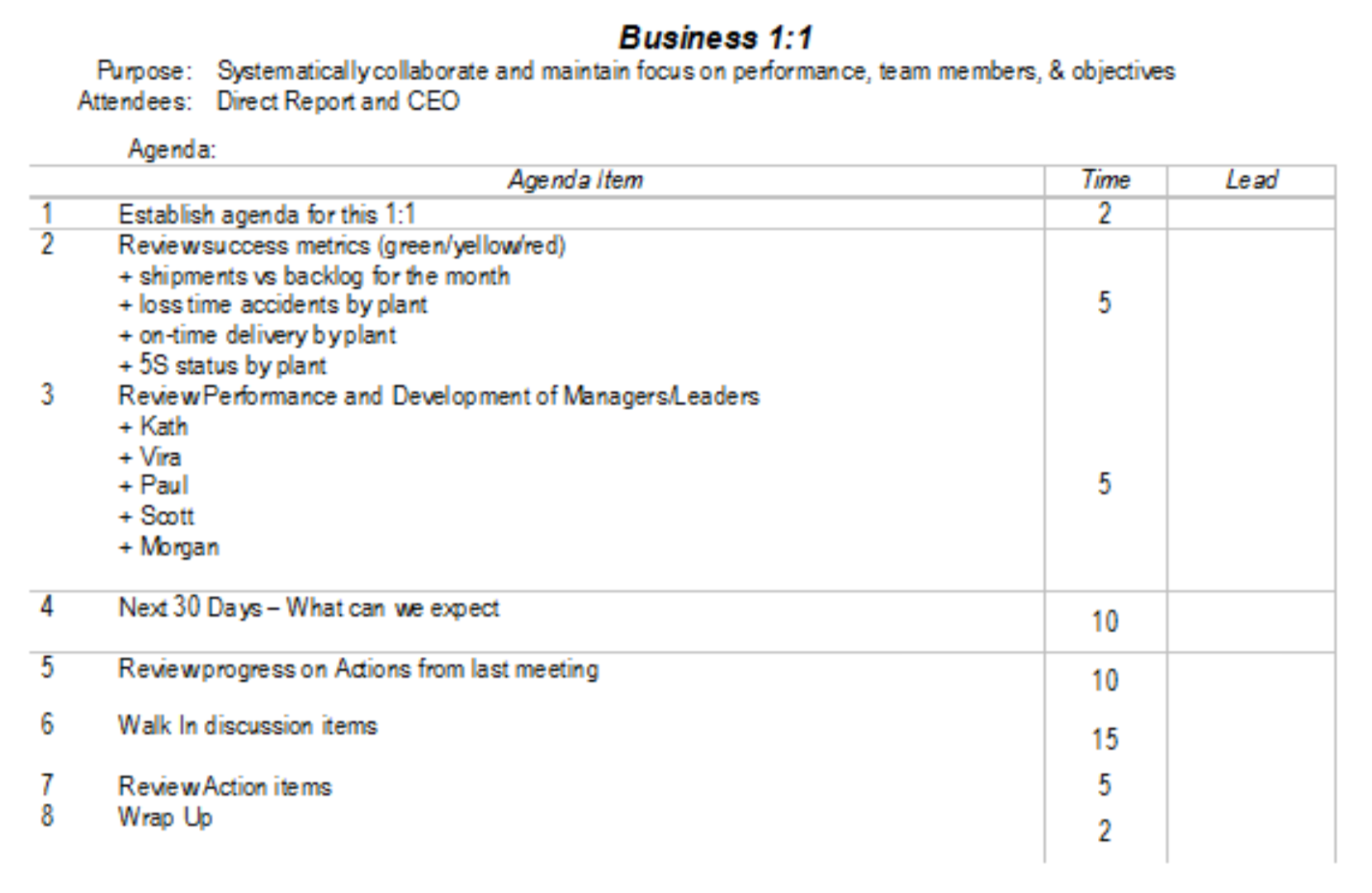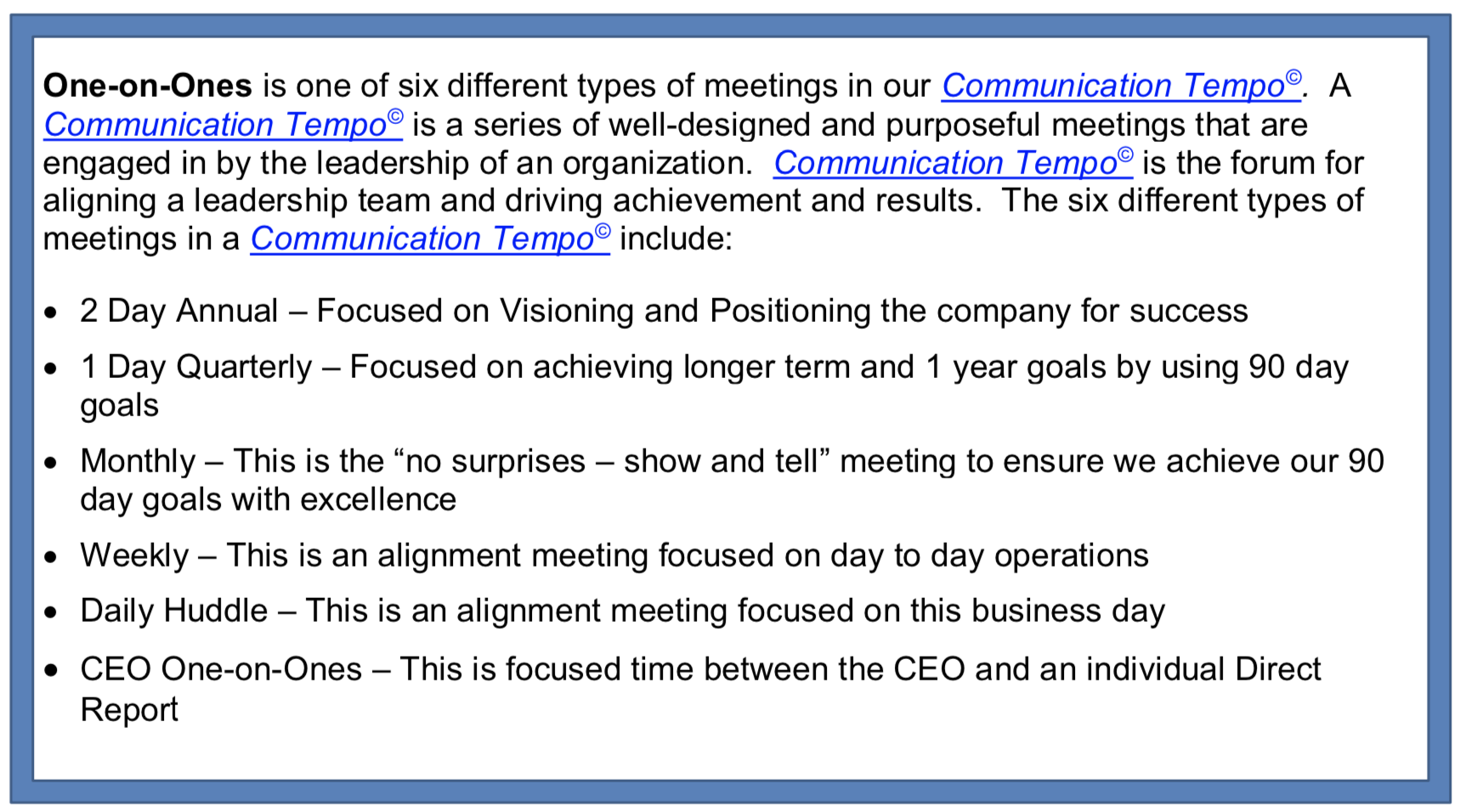
CEO One-on-Ones
One of the best and most effective tools a CEO can use are effective One-on-One meetings. One-on-One meetings are well-designed and purposeful, and this paper outlines best practices on how to perform effective One-on-Ones with Direct Reports.
What is a One-on-One?
A One-on-One meeting is where the CEO gives her/his undivided attention to one of their Direct Reports in a consistent and scheduled manner. One-on-One meetings are high level conversations that focus on discussing topics that are important and not urgent. One-on- Ones provide the forum to:
- Drive accomplishments and address business topics
- Reinforce alignment around the vision, purpose, and goals of the company
- Gain a clearer picture of how your Direct Report thinks and solves problems
- Provide quality time for coaching and mentoring
- Demonstrate that the Direct Report is valuable
- Model the behavior you want your Direct Report to use with their team members
- Establish and strengthen the connection between the CEO and his/her team members
The purpose of the One-on-One differs depending on whether you are leading or managing.
The purpose of the One-on-One differs depending on whether you are leading or managing. Yes, leading and managing are different and for most privately held companies the CEO and members of the leadership team are engaged in both operational and strategic functions. As a result, the CEO and the members of the leadership team have to be effective managers and growth focused leaders. For years I have heard people talk about the difference about being a manager verses a leader, and how leaders are focused on the future and managers are focused on the present. After years of reading and thinking about this topic I have concluded that the CEO and the members of the leadership team need to be proficient at both management and leadership.
What does it mean to be a manager and to be a leader? A manager ensures that the work their team is responsible for is done on time, on budget, and with quality. What is a Leader? A Leader grows the business and grows people. Growing people means inspiring, influencing, motivating, coaching, and creating an environment where employees feel energized and engaged.
Since management and leadership are two very different roles they need very different forums and agendas. When you wear your leadership hat, the Development One-on-One is the forum to use so you can focus on the development of your Direct Report. When you wear your management hat, the Business One-on-One is the forum to use so you can focus on the business and ensure that the work is being done on-time, on-budget and with quality. If we ignore either of these hats, we put at risk either growth or operations and neither of these is acceptable if you seek to be a high achievement growing company.
The picture below depicts the relationship of leadership and management and Development 1:1s and Business 1:1s.

We recommend that CEOs meet with their Direct Reports two times per month with one of the meetings serving as a Development One-on-One and the other meeting serving as a Business One-on-One.
Development One-on-Ones focus on the Direct Report and their development.
Development One-on-Ones focus on the Direct Report and their development: We refer to this meeting as “Getting People Done Through Work.” The Business One-on-One focuses on the business, goals, key performance indicators (KPIs), their department and their team member’s performance. We refer to this meeting as “Getting Work Done Through People.”
The table below provides a comparison between the two different types of One-on-Ones.

Development One-on-One – “Getting People Done Through Work”
The Development One-on-One should feel and look different than the Business One-on-One. We recommend that the Development One-on-One:
- Be held in the Direct Reports’ office or outside of the office over lunch, coffee, breakfast, etc.
- Occur once per month for approximately 60 to 90 minutes
- Be led by the CEO
- There is no formal paper agenda but this meeting does have purpose and direction
The Development One-on-One is NOT a “touchy-feely” meeting. These are important meetings that have significant impact to the business. Specifically, Development One-on- Ones provide the forum to:
- Increase employee engagement by as much as 72% by recognizing employees in a consistent and meaningful manner. (Source: Kenexa® WorktrendsTM Report)
- Know your Direct Reports and positively influence them. There is a well-known quote that states “I don’t care how much you know, until I know how much you care.” This quote speaks to the power and importance of knowing your Direct Reports and creating a relationship/connection.
The focus of the Development One-on-One is the Direct Report, their development, and their life goals. Effective Development One-on-Ones demonstrate how much you appreciate your Direct Report and help prevent burn out and/or losing an A-player to a competitor.
Development One-on-Ones: A Quick Story
I was working with a large publicly held company and introducing them to the concept of One- on-Ones. The Vice President of Culture and Human Resources (VP HR) stated, “We do not need Development One-on-Ones. Our culture is open and our team members openly share concerns. Also, we have a development program so these are not needed.” Approximately 9 months later one of the direct report of VP HR gave his notice out of the blue. The VP was surprised. He had been grooming this person to take over as the next Vice President of Culture and Human Resources. During the person’s exit interview, he cited the reason he was leaving was not for more money, not for more opportunity, he was leaving because he was working 80 hours a week and he did not see an end in sight. He had a young family and it was important to him to be a good father and husband. After this event the VP HR became a believer in the power of Development One-on-Ones and began conducting them on a regular basis.
By truly knowing your Direct Report you will know how to lead, influence, inspire, and recognize her/him in a meaningful manner.
The Development One-on-One is the forum for the CEO to make a real connection, build rapport, and strengthen the relationship with his/her Direct Reports. Development One-on- Ones create a connection because they help you know your Direct Report as a person and not just as an employee. By truly knowing your Direct Report you will know how to lead, influence, inspire, and recognize her/him in a meaningful manner. Leadership is about influence and the only way to effectively influence someone is to know them. If you can’t connect with someone, you cannot effectively lead them. Development One-on-Ones provide the opportunity to connect and learn what drives your Direct Report.
According to Anthony Robbins there are 6 core human needs that drive all human behavior. Everyone has the same six needs, but how we value and prioritize those needs determines the direction of our life. The 6 core human needs are:
According to Anthony Robbins there are 6 core human needs that drive all human behavior. Everyone has the same six needs, but how we value and prioritize those needs determines the direction of our life. The 6 core human needs are:
- Certainty: The need for safety, stability, security, comfort, order, predictability, control and consistency. This affects how much risk we are willing to take in life—in our jobs, in our investments, and in our relationships. The higher the need for certainty, the less risk you’ll be willing to take or emotionally bear. By the way, this is where your real “risk tolerance” comes from.
- Variety: The need for variety, surprise, challenge, excitement difference, chaos, adventure, change and novelty.
- Significance: The need to have meaning, to feel special, pride, needed, wanted, a sense of importance and recognition. We all need to feel important, special, unique, or needed. So how do some of us get significance? You can get it by earning billions of dollars or collecting academic degrees—distinguishing yourself with a master’s or a PhD.
- Love and Connection: The need for communication, unified, approval and attachment, to feel connected and loved by other human beings.
- Growth: The need for constant emotional, intellectual and spiritual development.
- Contribution: The need to give beyond ourselves, give, care, protect, and serve others.
These six needs are varied and a team member who prioritizes “growth” should not be coached and developed in the same manner as someone who prioritizes “certainty.” In the absence of identifying someone’s core needs we have a tendency to communicate, coach and lead from the position of our core needs. Since the goal of the Development One-on-One is connection, we need to flex our coaching and leadership to their style and the only way we can effectively do that is if we really get to know them.
These six needs are varied and a team member who prioritizes “growth” should not be coached and developed in the same manner as someone who prioritizes “certainty.” In the absence of identifying someone’s core needs we have a tendency to communicate, coach and lead from the position of our core needs. Since the goal of the Development One-on-One is connection, we need to flex our coaching and leadership to their style and the only way we can effectively do that is if we really get to know them.
The Development One-on-One is an opportunity to align as much as possible your Direct Report’s life goals with business goals and opportunities.
During the Development One-on-One, the CEO’s job is to listen and stay focused on the Direct Report. In addition to learning about your Direct Report and what is important to them, the Development One-on-One is an opportunity to align as much as possible your Direct Report’s life goals with business goals and opportunities. For example, if your Direct Report is interested in living in another State or another Country, that is great information to know especially when the company seeks to expand into new regions.
Development One-on-Ones discussion topics include but are not limited to:
- What are your life goals?
- What does success look like for you outside of work?
- How is your work life balance?
- What are your professional development goals?
- How are your development plans coming along?
- How is your job satisfaction?
- Sharing “bits of brilliance” that you as the CEO have observed in them over the last month
- What skill, if developed and performed with excellence, would have the greatest impact on the company/your career?
- What would cause you to leave and take a position with another company?
- How do you like to be rewarded and recognized?
- What accomplishment or item are you really proud of?
- What is interfering or keeping you from doing your best work?
- When was the last time you felt valued and appreciated?
- What part of your job do you enjoy the most?
- What part of your job do you enjoy the least?
Two Times per year, the Development One-on-One should include a discussion on delegation. Specifically, the CEO should ask the Direct Report to identify one item that he/she can delegate to one of their Direct Reports forever, and one item that the CEO should delegate to this Direct Report. By doing this, the CEO and Direct Report are constantly developing and exposing team members to more and more of the business.
What the CEO should NOT do:
- If your Direct Report is having personal problems such as martial or family problems, do NOT counsel them. Let them know you want to support them and refer them to your employee assistance program or a counselor.
- Do NOT become BFFs (Best Friends Forever) with your Direct Report, vacation with them, or invite them over for holiday dinners with their family. There is a fine line between appreciating them and supporting them and becoming BFFs. At the end of the day, you are still their boss and creating a BFF situation is confusing for both you and them.
- Avoid telling your Direct Report your stories, your life goals, etc.
- Avoid giving them work assignments.
The Business One-on-One is the forum to use so you can focus on the business and ensure that the work is being done on-time, on-budget and with quality.
Business One-on-One – “Getting Work Done Through People”
The Business One-on-One should feel and look different than the Development One-on-One. We like to refer to the Business One-on-One as “Getting Work Done Through People” because it focuses on the company and department performance.
The purpose of the Business One-on-One is for the CEO to focus on information that is important and NOT urgent. The Business One-on-One is a focused update on the company, their department, their goals, their team members, etc.
The Business One-on-One should feel and look different than the Development One-on-One. We recommend that the Business One-on-One:
- Be held in the CEO’s office
- Occur once per month for approximately 60 to 90 minutes
- Be led by the Direct Report
- There is formal paper agenda which includes 2 parts:
- Part 1: A defined set of agenda topics such as metrics, strategic goals, development plans for team members, etc. (see sample agenda below)
- Part 2: Walk In topics: This is an open time for your Direct Report to talk about anything else they want to discuss/share with you. This is a great opportunity to see how your Direct Report thinks and leads. This open time can also be used by the CEO to discuss/share information, ask probing questions, get feedback on initiatives you may be considering, ask for feedback, opinions, input to important decisions, etc. (see sample agenda below)
The format and agenda of the Business One-on-One is jointly designed by you and your Direct Report and should reflect how your Direct Report leads, thinks and operates. The Business One-on-One involves discussions around:
- Updates on projects
- What can be expected for next month
- Identification and removal of barriers that hinder the company and/or the department
- Review performance metrics, quotas, or project updates
- Review and become familiar with the performance of their Direct Reports
- Recognize Achievements
What the CEO should NOT do:
- Accumulate a list of assignments for the Direct Report and then use the Business One- on-One to share the assignments/projects
- Use the Business One-on-One to administer a performance review
- Frequently cancel or cut short the Business One-on-One
Sample 60-minute Business One-on-One Agenda:

Measuring the Effectiveness of your One-on-Ones
So how do you know if your One-on-Ones are positive and effective? Simply observe your Direct Report and assess his/her energy. Did he/she thank you for meeting with them, or are they doing everything they can do to cancel the meeting and/or get out of your office? Is the conversation open or is it like pulling teeth? Effective One-on-Ones cultivate a connection that you can see, hear and feel.
One-on-Ones is one of six different types of meetings in our Communication Communication Tempo©. A Communication Communication Tempo© is a series of well-designed and purposeful meetings that are engaged in by the leadership of an organization. Communication Communication Tempo© is the forum for aligning a leadership team and driving achievement and results. The six different types of meetings in a Communication Tempo© include:
- 2 Day Annual – Focused on Visioning and Positioning the company for success
- 1 Day Quarterly – Focused on achieving longer term and 1 year goals by using 90 day goals
- Monthly – This is the “no surprises – show and tell” meeting to ensure we achieve our 90 day goals with excellence
- Weekly – This is an alignment meeting focused on day to day operations
- Daily Huddle – This is an alignment meeting focused on this business day
- CEO One-on-Ones – This is focused time between the CEO and an individual Direct Report

